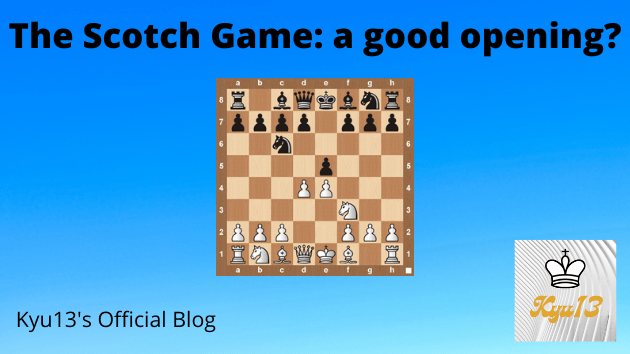
The Scotch Game: a good opening?
The scotch game (1.e4 / e5, 2. Nf3 / Nc6, 3. d4) has been very popular in the begin of the 19th century, but is now much less played: actually, it represents only 0,9% of all the games played! Known to be an aggressive opening, players of the world have found something much more aggressive: the Scotch Gambit! Instead of playing 4. Nxd4 after 3. … / exd4, they have decided to give the pawn and to continue with 4. Bc4! They develop the piece to get an advance in their development and to attack easier and faster the black king.
In this article, we will see the origins of the Scotch Game, the main line, then the most common variants, the best titled players that decide to play with it and finally, we will watch the best trap and conclude by answering the title question: is the Scotch Gambit a good opening?
1/ The origins of the Scotch Game
Chess players read for the first time in 1750 the moves of the Scotch Game in the treatise of Ercole di Rio, “On the game of Chess, practical Observations by an anonymous Modenese Author”, and in 1824, we called this opening the “Scotch Game”! The reason of his name is the match between the London’s and Edinburgh’s clubs: the Edinburgh’s players have successfully played 2 games with the Scotch Opening and the third has been decided as a draw! However, the opening was not enough shared by the players and has been forgot until Grandmaster Garry Kasparov did start to play it! Yes, one of the most famous chess players did use the Scotch Game for most of his game when he had the white pieces! Furthermore, he played the opening three times in world championships (1990, 1993 and 1993), which gave again popularity to the Scotch Game of the Edinburgh’s chess players! The strategical optic of the opening is much appreciated by very talented players, like Magnus Carlsen and Ian Nepomniachtchi! Maybe, we will find the opening in one of the next world championships!
2/ The main line
The Scotch Game begins after the moves 1.e4 e5 2.Nf3 Nc6 3.d4. By taking the pawn at the fourth move, Black does allow White to win the center with 5. Nxd4 / Nxd4, 6. Qxd4.
White wants and can control the square e5 and have a clear space advantage. But on the other side, White has moved two times their knight and Black is not forced to follow the main line! Moreover, the development will be small, and the game will quick enter in the middlegame, what does mean that the game will be more than aggressive!
3/ The most common and interesting variants
- The Schmidt Variation:
Anatoli Karpov’s favorite variation of the Scotch Game is remarkably interesting, because White did move two times the same Knight and will need to exchange them on c6, what means that they loose 2 tempos. With the e4-e5 push, White tries to win a tempo back, but still has lost one tempo. On the other hand, Black does get a double pawn on the c-column, because they won this tempo.
- The Classical Variation:
Again, White loses two tempos and will exchange the knights on the c6-square, but this time, Black develops a bishop on c5 instead of the knight on f6, which does not permit White to win a tempo back!
- The Scotch Gambit:
In my opinion, this is the most aggressive and tactical variant of the Scotch Game for White. Indeed, we give the pawn but have an advance in our development and do not loose any tempo! Furthermore, it’s not possible for Black to try to attack, because the black king needs to castle after the moves Bc5 and Nf6.
- The Goring Gambit:
This time, White directly offers Black a gratis pawn for the development of the b-Knight. Black can decide to accept the gambit and to help the development of the white pieces, or to develop their own pieces, but to lose a tempo because of cxd4!
- The Malaniuk Variation:
In the Malaniuk Variation, Black directly gives the check with their bishop on the b4-square, to force White playing c2-c3 and to block because of the push the development of the b-Knight. Nd2 is impossible because of Nxd4!
That’s all with the most common variants and possible first moves! Naturally, chess players do always try new things and you can find many interesting positions and other variants in the database of chess.com!
4/ The GMs that decided to play the Scotch Game:
We have three Grandmasters that play the Scotch Game in their games as opening for famous tournament: Ian Nepomniachtchi (specialized in the Scotch Gambit!), Alexander Grishuk (loves to play it in his blitz games!) and Magnus Carlsen (maybe he will play it against Ian Nepomniachtchi in the world Championship?) and many others, who do not play it very often, but have it in their aggressive repertories of openings!
5/ The best trap!
Probably the part that I prefer in an opening-explanation: the best trap! The position that happens often on the board at an intermediate level, and sometimes in titled players games too! For the Scotch Game, I’ve chosen a trap of the Scotch Gambit Variation:
If you know more traps of the Scotch Game, you can naturally share them in the comments!
6/ Conclusion:
To sum it all up, the Scotch Game with its many variations is less knows than other openings like the Italian Game or the Sicilian for example but is still important and findable in GMs Games. Aggressive but still solid, it offers White many possibilities to attack the black king but can be dangerous too if the attack does fail, because the gambit-variations do directly loose a pawn and the main-line can be followed by many traps created by Black! Be careful before starting an attack on the opponent’s castle! (Advice: do castle as fast as possible with Black, or you will suffer of a terrible attack from the white pieces!)
Maybe you have now decided to play it too? I wish you luck for your next games with this very interesting opening!
My next article will be about the full theoreticality of the Scotch Gambit!
Thank you very much for reading and have a great day!
For more blogs, articles, and news, feel free to send me a friend request or to follow my blog.
@Kyu13
More blogs written by @Kyu13:
The main question: how to become a stronger player?
Puzzle Road:
[Puzzle Road] Attack, Block and Take (P1)


